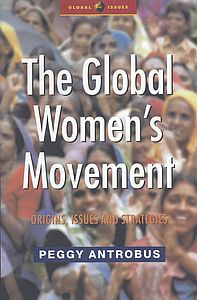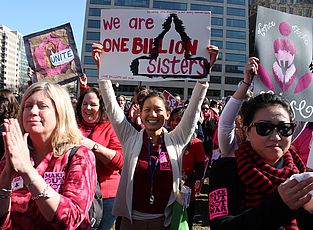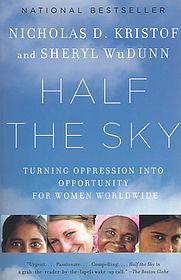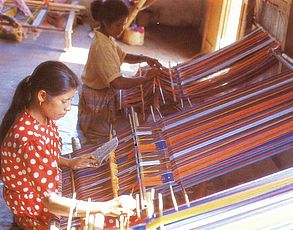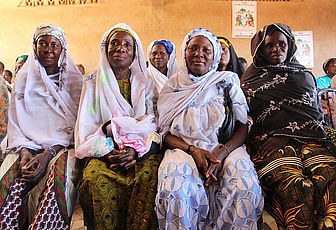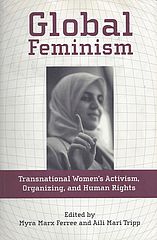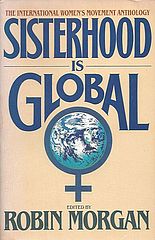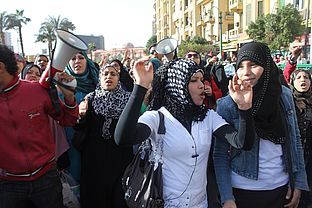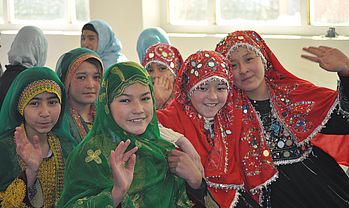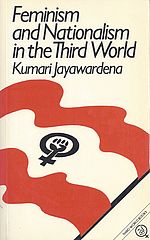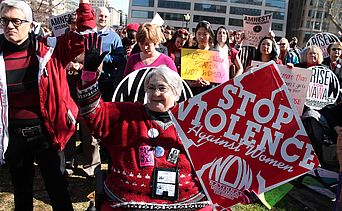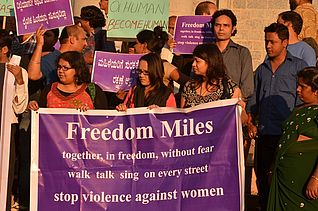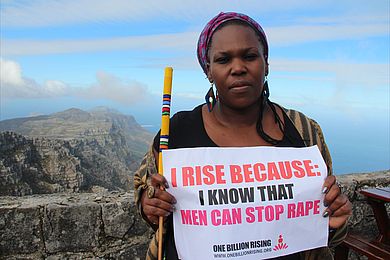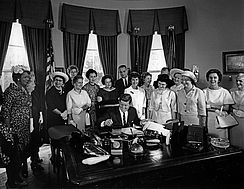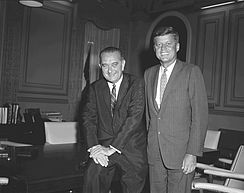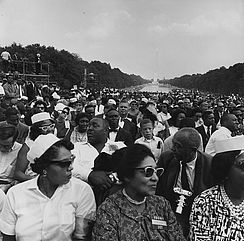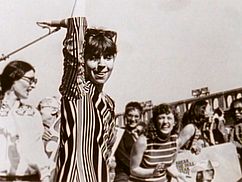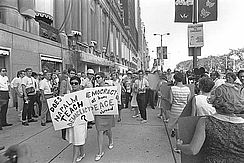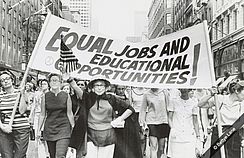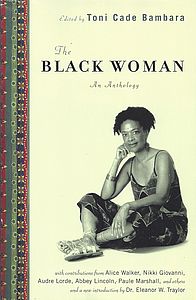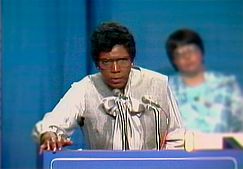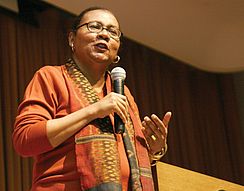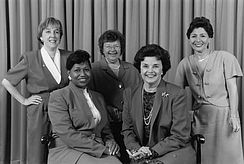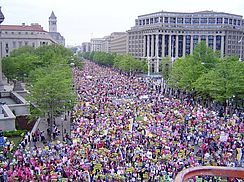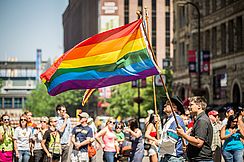Politics & Social Movements
Global Feminism
Activists around the world joined forces on V-Day to protest violence against women in 2013.
Video by Eve Ensler and One Billion Rising. (Running time 4:33) Used with permission.
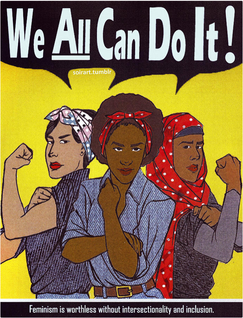
In 1995, more than 30,000 citizens of the world journeyed to Beijing for the Fourth United Nations World Conference on Women, where they heard First Lady Hillary Rodham Clinton proclaim, “If there is one message that echoes forth from this conference, let it be that human rights are women’s rights and women’s rights are human rights once and for all.” The conference platform set three preconditions for women’s global advancement — equality, development, and peace — and boldly situated women’s issues within broader social and economic transformation. In this formulation, practically everything was now a women’s issue.
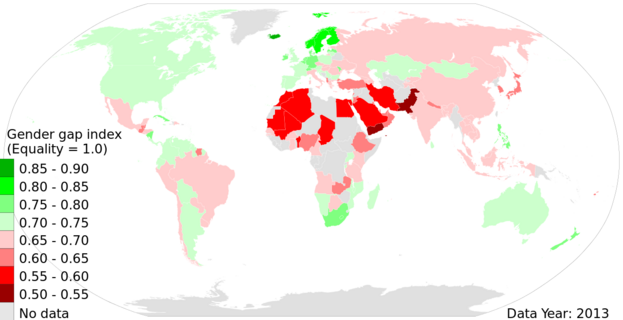
While sisterhood had become global by the 1990s, no notion of universal sisterhood undergirded the rise of global feminism. Instead, a diverse and decentralized multiplicity of local forms of feminism, more like a mosaic or patchwork quilt, linked the local to the global, often bypassing national borders. Even though major theoretical insights like the definition of women’s rights as human rights could travel from the international level down to local activists to use as leverage in their own struggles, just as often ideas and energy percolated up. Making links between global trends and local realities is at the core of global feminism. So too is a belief in empowering women as agents of social change.
In the story of how global feminism became a vibrant worldwide phenomenon, the United Nations served as what one scholar called an “unlikely godmother” by sponsoring a series of conferences that brought together women from all over the world. Following the designation of 1975 as the International Year of the Woman, the first UN Women’s Conference was held in Mexico City. When it became clear that the myriad issues on the agenda could not possibly be addressed in a year, the initiative was expanded into the International Decade of Women, with additional conferences held in Copenhagen in 1980 and Nairobi in 1985. As Caribbean activist and participant Peggy Antrobus noted, the Decade of Women “opened spaces for women from communities all over the world to meet” and it helped them find “their public voice at the international level.” In an increasingly globalized world, these contacts and networks grew exponentially.
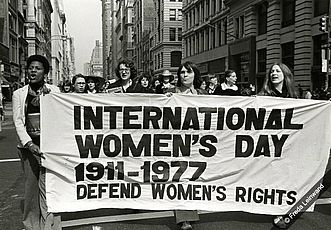
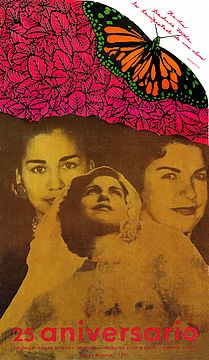
Still, finding common ground about what constituted women’s issues was challenging. Especially at the beginning, there was a clear rift between women from the Global North (industrialized Europe, North America, Japan, and Northern Asia), who tended to focus on questions of legal rights and women’s social and political equality, and women from the Global South (Africa, the Asian subcontinent, and Latin and South America), who looked more broadly at questions of poverty, disease, and the need for economic development as most relevant to women’s advancement. “To be equal in poverty with men is no blessing,” said one Copenhagen participant succinctly. By the time of the Beijing conference in 1995, there was a much stronger consensus on the need for global economic and political transformation as a prerequisite for changing women’s lives, although political rights and legal equality still remained on the agenda.
Besides the opportunity to develop networks and make connections beyond traditional borders, one of the most important contributions of the UN conferences was collecting the data and statistics that were then analyzed to help scholars understand why, despite equal sex ratios at birth and the fact that women generally live longer than men, in countries such as China, Pakistan, and India, men outnumbered women. According to economist Amartya Sen, lack of access to maternal healthcare, poor childhood nutrition, and female infanticide are among the reasons that 100 million women are “missing” from the global population. As Nicholas Kristof and Sheryl WuDunn put it, “In much of the world, women die because they aren’t thought to matter.” Under the UN mandate, countries have begun collecting information about maternal death rates, life expectancy, poverty, and a host of other factors that give a human face to the half of the world’s population who, in the words of the Chinese proverb, hold up half the sky. And better data has provided the foundation for increased activism.
Spurred in part by the Beijing conference, the decade of the 1990s saw a surge in global feminist activism, much of it centered on the issue of violence toward women. Studies documented how sex trafficking was a widely dispersed international phenomenon, with girls and young women living in virtual slavery. The practice of female genital mutilation came under attack, and honor killings were publicized, drawing worldwide condemnation. Ongoing ethnic and regional conflicts also focused world attention on the use of mass rape as a weapon of war. Unlike genocide and other mass killings, rape does not leave corpses, but it is just as devastating, as was seen in Bosnia, Rwanda, the Congo, Liberia, and Darfur, among other places. In wartime it was often more dangerous to be a woman than a soldier.
U.S. women played an important, but hardly dominant, role in the rise of global feminism. In the 1980s, American feminists, stymied at home by the rise of conservatism and the backlash against feminism, welcomed the chance to take their activism to the world stage, providing important seed money and talent through organizations such as the Feminist Majority Foundation and the International Planned Parenthood Federation. Robin Morgan founded the Sisterhood Is Global Institute, and Charlotte Bunch established the Center for Women’s Global Leadership at Rutgers University.
Since the 1990s, much of the energy and driving passion of global feminism has come from the Global South. Some observers have noted a certain complacency from women in the better-off Global North, a tendency to think that women’s issues have basically been taken care of in their industrialized or post-industrial countries. Additionally, feminists in the Global North often zero in on practices found primarily in Muslim countries — such as honor killings, wearing the burqa, or female genital mutilation — as evidence of profound cultural differences in the treatment of the sexes. Horrific as they are, why do the fifteen honor killings a year in Jordan get so much more attention than the three thousand women killed each year in the United States in domestic violence? No country is immune from domestic abuse, and more American feminists are making connections between domestic conditions affecting women’s lives in the United States and similar problems on the global feminist agenda.
Eve Ensler certainly makes the connection. Building on the success of The Vagina Monologues, Ensler’s theatrical production based on interviews with more than 200 women (including women raped in Bosnia in the early 1990s), in 1998 she founded V-Day (February 14). As a non-profit organization V-Day held benefit productions of The Vagina Monologues around the world and raised over $100,000 for groups dedicated to ending violence against women and girls. In 2012, V-Day orchestrated a new campaign — One Billion Rising — as a dramatic global demonstration to mobilize mass action on the issue. (The “one billion” is derived from the UN statistic that one in three women will be raped or beaten during her lifetime.) On V-Day 2013 activists from over 190 countries demonstrated their united and ongoing commitment to preventing violence against women and girls. One Billion Rising continues to be the largest global action on this issue in history.
Social media made the mobilization behind One Billion Rising possible. Feminists can now collaborate and take action in ways that were inconceivable even just ten years ago. The United Nations may have been the unlikely godmother of global feminism, but the Internet and social media are its lifelines, linking the local to the global in our increasingly interconnected and information-driven world. The possibilities for dispersing critical information, sharing contacts and strategies, and mobilizing literally billions of people around the globe are the way of the future, women’s and everyone else’s.
How to Navigate our Interactive Timeline
You will find unique content in each chapter’s timeline.
Place the cursor over the timeline to scroll up and down within the timeline itself. If you place the cursor anywhere else on the page, you can scroll up and down in the whole page – but the timeline won’t scroll.
To see what’s in the timeline beyond the top or bottom of the window, use the white “dragger” located on the right edge of the timeline. (It looks like a small white disk with an up-arrow and a down-arrow attached to it.) If you click on the dragger, you can move the whole timeline up or down, so you can see more of it. If the dragger won’t move any further, then you’ve reached one end of the timeline.
Click on one of the timeline entries and it will display a short description of the subject. It may also include an image, a video, or a link to more information within our website or on another website.
Our timelines are also available in our Resource Library in non-interactive format.
Timeline Legend
Yellow bars mark entries that appear in every chapter
This icon indicates a book
This icon indicates a film
1971 The Click! Moment
The idea of the “Click! moment” was coined by Jane O’Reilly. “The women in the group looked at her, looked at each other, and ... click! A moment of truth. The shock of recognition. Instant sisterhood... Those clicks are coming faster and faster. They were nearly audible last summer, which was a very angry summer for American women. Not redneck-angry from screaming because we are so frustrated and unfulfilled-angry, but clicking-things-into-place-angry, because we have suddenly and shockingly perceived the basic disorder in what has been believed to be the natural order of things.” Article, “The Housewife's Moment of Truth,” published in the first issue of Ms. Magazine and in New York Magazine. Republished in The Girl I Left Behind, by Jane O'Reilly (Macmillan, 1980). Jane O'Reilly papers, Schlesinger Library.


